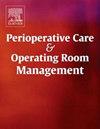Comparative study of Thiopentone and Propofol for induction of anaesthesia in adult population- a randomized clinical trial
IF 1
Q2 Nursing
Perioperative Care and Operating Room Management
Pub Date : 2025-06-19
DOI:10.1016/j.pcorm.2025.100513
引用次数: 0
Abstract
Background
Modern medicine relies on general anesthesia. However, due to climate change and geopolitical instability, medicine shortages and supply chain disruptions are having a growing impact on the global healthcare environment. Applying high reliability organization (HRO) principles, healthcare systems must ensure consistent access to key anaesthetic agents. To assess clinical results and implications for sustainable anaesthetic procedures, this study compares thiopentone with propofol as a case study.
Methods
A Prospective, randomised, single-center cohort study. 190 adult patients in the age group of 18–70 years scheduled for different surgical procedures under general anaesthesia were carried out at a tertiary care hospital (Department of Anaesthesiology, SKIMS Medical College and Hospital, Srinagar). Patients were randomly assigned to either propofol or thiopentone to induce anesthesia. Along with qualitative markers such induction smoothness, recovery, and consciousness levels, hemodynamic data such as heart rate, systolic and diastolic blood pressure, and breathing rate were examined.
Results
Both drugs were clinically efficacious and safe. In terms of quicker induction, easier recovery, and general patient satisfaction, propofol performed better (90 % vs. 85 %). It dramatically lowered systolic blood pressure (from 129 ± 11 to 102 ± 9.9 mmHg) and heart rate (from 90 ± 15 to 80 ± 13 beats/min). On the other hand, thiopentone also decreased blood pressure and heart rate, but less significantly. Group differences in respiratory patterns revealed varying physiological reactions.
Conclusion
Although thiopentone and propofol both works well to induce anesthesia, propofol is more patient-acceptable and offers better hemodynamic stability. However, in environments with limited resources, thiopentone is a more practical choice due to its simpler availability and cheaper cost. To improve system resilience—a crucial quality of high reliability organizations functioning under the strains of global supply chain volatility—this case study emphasizes the need of preserving flexibility and redundancy in anesthesia protocols.
Trial registration
The trial was registered prospectively in the Clinical Trial Registry of India (CTRI/2023/02/049,428) registered on 03/02/2023. The first subject was recruited on 05/02/2023.
硫喷妥酮与异丙酚在成人麻醉诱导中的比较研究——一项随机临床试验
现代医学依赖于全身麻醉。然而,由于气候变化和地缘政治不稳定,药品短缺和供应链中断正在对全球医疗保健环境产生越来越大的影响。应用高可靠性组织(HRO)原则,医疗保健系统必须确保对关键麻醉剂的一致访问。为了评估可持续麻醉程序的临床结果和意义,本研究比较了硫喷酮和异丙酚作为一个案例研究。方法前瞻性、随机、单中心队列研究。在一家三级护理医院(斯利那加SKIMS医学院和医院麻醉科),计划在全身麻醉下进行不同手术的190名18-70岁成年患者进行了手术。患者被随机分配使用异丙酚或硫喷妥来诱导麻醉。除了诱导平滑度、恢复和意识水平等定性指标外,还检查了心率、收缩压和舒张压、呼吸率等血流动力学数据。结果两种药物临床有效、安全。在诱导更快、恢复更容易和总体患者满意度方面,异丙酚的效果更好(90%比85%)。它显著降低了收缩压(从129±11降至102±9.9 mmHg)和心率(从90±15降至80±13次/分钟)。另一方面,硫喷妥酮也能降低血压和心率,但效果不明显。各组呼吸模式的差异揭示了不同的生理反应。结论硫喷妥酮与异丙酚诱导麻醉效果均较好,但异丙酚更易为患者接受,血流动力学稳定性更好。然而,在资源有限的环境中,硫喷妥酮是一个更实用的选择,因为它更容易获得,成本更便宜。为了提高系统弹性——高可靠性组织在全球供应链波动的压力下运作的关键品质——本案例研究强调了在麻醉方案中保持灵活性和冗余的必要性。试验注册该试验已于2023年2月3日在印度临床试验注册中心(CTRI/2023/02/049,428)注册。第一名受试者于2023年2月5日招募。
本文章由计算机程序翻译,如有差异,请以英文原文为准。
求助全文
约1分钟内获得全文
求助全文
来源期刊

Perioperative Care and Operating Room Management
Nursing-Medical and Surgical Nursing
CiteScore
1.30
自引率
0.00%
发文量
52
审稿时长
56 days
期刊介绍:
The objective of this new online journal is to serve as a multidisciplinary, peer-reviewed source of information related to the administrative, economic, operational, safety, and quality aspects of the ambulatory and in-patient operating room and interventional procedural processes. The journal will provide high-quality information and research findings on operational and system-based approaches to ensure safe, coordinated, and high-value periprocedural care. With the current focus on value in health care it is essential that there is a venue for researchers to publish articles on quality improvement process initiatives, process flow modeling, information management, efficient design, cost improvement, use of novel technologies, and management.
 求助内容:
求助内容: 应助结果提醒方式:
应助结果提醒方式:


